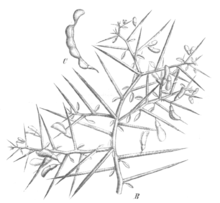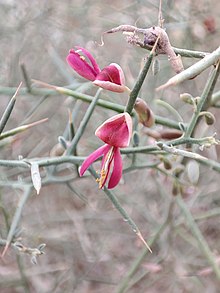

| Alhagi | |
|---|---|

| |
| Alhagi maurorum | |
| Scientific classification | |
| Kingdom: | Plantae |
| Clade: | Tracheophytes |
| Clade: | Angiosperms |
| Clade: | Eudicots |
| Clade: | Rosids |
| Order: | Fabales |
| Family: | Fabaceae |
| Subfamily: | Faboideae |
| Tribe: | Hedysareae |
| Genus: | Alhagi Tourn. ex Gagnebin (1755) |
| Type species | |
| Alhagi maurorum Medik. | |
| Species[1] | |
| |
| Synonyms[1] | |
|
Manna D.Don (1825) | |





Alhagi is a genus of Old World plants in the family Fabaceae. They are commonly called camelthornsormanna trees. There are four accepted species, which range from northern Africa and Greece through western and central Asia to India and northern China.[1]
Alhagi species have proportionally the deepest root system of any plants[citation needed] - a 1 m (3 ft 3 in) high shrub may have a main root more than 15 m (49 ft) long; due to their deep root system Alhagi species are drought-avoiding plants that utilize ground water, adapting in that way perfectly to the hyper-arid environment.
Alhagi species are used as food plants by the larvae of some Lepidoptera species including Coleophora argyrella which feeds exclusively on A. maurorum.
The genus name comes from the Arabic word for pilgrim.
Four species are accepted:[1]
AlhagiinPersianisخارشُتُر (xâr-e šotor) which means "thistle of camels", as camels can eat it with its thorns. Its foliage is the habitat of a scale insect which produces Manna of hedysarum or Tarangabeen, which is used as a remedy for neonatal jaundice.[2]
{{cite journal}}: Cite journal requires |journal= (help)
| Authority control databases: National |
|
|---|
This Faboideae-related article is a stub. You can help Wikipedia by expanding it. |